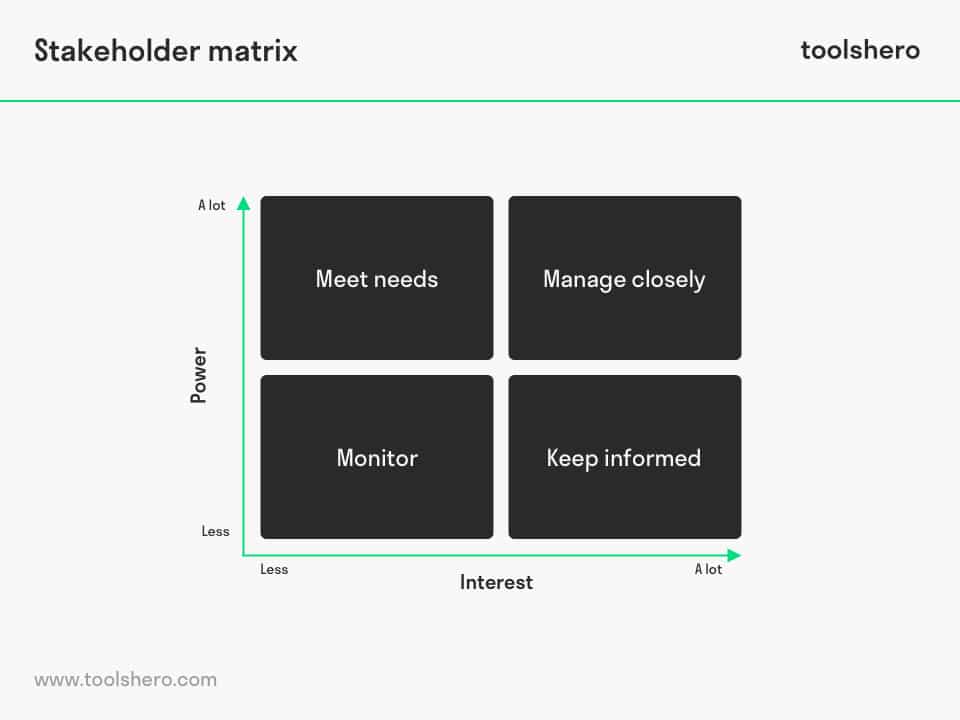Stakeholder Analysis explained plus template

Stakeholder Analysis: this article provides a practical explanation of a Stakeholder Analysis. It also gives an example, a step-by-step plan and a stakeholder analysis matrix. It furthermore contains a downloadable and editable Stakeholder Analysis template. After reading the article, you will have a basic understanding of this change management tool.
What is a Stakeholder Analysis?
A stakeholder analysis is a technique to identify important stakeholders and their needs in a company, system, project or other process. This concerns the evaluation of the system or company and the question whether changing that system will impact the stakeholders.
The goal of a stakeholder analysis is to identify stakeholder groups and the relationships between stakeholders and their needs, and subsequently base a strategic vision on this. It is an important part of stakeholder management and the project plan.
The tool is used in many scenarios and fields. Generally speaking, when analysing a problem or situation, a stakeholder analysis consists of weighing and balancing all the contradictory needs of everyone claiming to be involved. The exact method might differ per situation.
An analysis on stakeholders is conducted in many different situations: from project management to financial management, and from crisis or disaster situations to major changes that are being implemented within organisations.
Stakeholder is a broad term and different people are viewed as stakeholders in different situations and contexts. Key stakeholders of an organisation could include employees, customers, suppliers and much more.
These are just a few groups of stakeholders. In a collision, for instance, there could be other stakeholders or involved parties, such as the drivers, bystanders or owners.
Stakeholder Analysis Example and Stakeholder Influence
The stakes are high in the business world and, often, a lot of money is involved. A stakeholder of an organisation is a person who has an interest in the activities conducted by the organisation. Because many different people are involved in an organisation, there might also be opposite interests.
The stakeholder analysis offers a helping hand in this. Generally speaking, we can distinguish between three different kinds of stakeholders. These are important to be able to distinguish between the stakeholders in the step-by-step plan later.
Primary stakeholders
Primary stakeholders are usually stakeholders within the organisation. They are also referred to as internal stakeholders. These stakeholders are involved in economic transactions of the organisation. Examples include:
- Customers
- Shareholders
- Suppliers
- Creditors
- Investors
- Employees
The interests for primary stakeholders are significant, particularly when it comes to investors and creditors.
The article on financial accounting shows that these two stakeholders are primary users of financial pieces of the organisation.
Shareholders own the organisation, and their interests carry much weight. Together, they decide what the course of the organisation looks like.
Secondary stakeholders
Secondary stakeholders are generally external interested parties, people outside the organisation.
Although these stakeholders do not directly participate in economic activities with the organisation, they are affected by its business activities, and thus crucial to take into consideration while performing the stakeholder analysis.
Because the impact of those activities can be significant, these stakeholders also receive a lot of attention. Examples of secondary stakeholders include:
- Communities
- Activists
- The public
- Media
- Trade unions
- Governments
- Competitors
Stakeholder Analysis: stakeholders in other business situations
It’s important to understand that there are different stakeholders in different contexts and situations. On a corporate level, an organisation-wide level, the stakeholders are other people than in the smaller departments of an organisation.
Financial Accounting
As can be read in financial accounting, information gained through financial accounting is shared with external users. These stakeholders mainly include investors and creditors.
Project Management
Stakeholders play an important role in project management as many people generally have an interest in a project.
Primary stakeholders are people who have an immediate effect on the success and failure of a project, such as the project members or sponsors. Typical stakeholders in project management are:
- Customers
- Project manager
- Project team
- Sponsor
Stakeholder Analysis: a step-by-step plan
It’s essential to map the various stakeholders because they might have a significant impact on the success of an organisation, project or other process.
Conducting a stakeholder analysis via a stakeholder map tool or our template is a fixed part of effective stakeholder management.
There are three steps that must be followed in the stakeholder analysis.
Step 1: identify all stakeholders
To be able to communicate with the stakeholders, as established in a communication plan, they must first be identified. Therefore, it is important to make sure that both the primary and secondary stakeholders have been identified.
When making a list, think of everyone who might have influence on or might be influenced by the project. People who benefit from the success or failure of a project or organisation are also important.
- Who might have a negative impact on the success of the project or organisation?
- Have both the supporters and opponents been identified?
- What is the relationship between these stakeholders?
Step 2: assess the stakeholders and sort them by influence
When the stakeholders have been identified, it’s important to sort them based on their impact and power. The groups of stakeholders can subsequently be divided across the stakeholder matrix. This will be explained in the next section.
Step 3: understand the stakeholders
It’s important for the project manager or business manager to know what the stakeholders think of a project, and what they like or dislike about it. This enables the manager to develop a perspective on what the stakeholders expect to gain from the project.
Ask yourself the following questions:
- Do stakeholders have a financial or other interest?
- Which information is valuable to them and how can this best be communicated to them?
- What is their opinion?
- Who or what influences their opinion?
- Are there mutual relationships between stakeholders that might change this opinion?
- How could possible hostile actions be avoided?
The information that is gained here is used to get an idea of exactly which stakeholders exert how much influence, and how these stakeholders can best be handled. After all stakeholders and their interests and influence have been established, these can be included in the stakeholder matrix.
Stakeholder Analysis Matrix
The stakeholder matrix, or power interest grid, is a visualisation where the stakeholders from the stakeholder analysis are plotted in a matrix. The matrix assesses the stakeholders in terms of power and interest. High power highly interested stakeholder groups are plotted top right.

Figure 1 – Stakeholder Analysis Template
A lot of power, a lot of interest (manage closely)
These stakeholders should be involved in as many activities as possible, and great effort should be put into keeping this group satisfied through stakeholder communications.
A lot of power, less interest (meet needs)
These people should be kept satisfied, but not too much information should be shared with them that they’re not interested in.
Less power, a lot of interest (keep informed)
These stakeholders should be kept informed, because they can often offer creative ideas or other input thanks to their interest or stakes in the project.
Less power, less interest (monitor)
This group of stakeholders should be monitored, but it is not necessary to deploy a lot of resources to keep them happy.
Stakeholder Analysis template
Start visualising in what way stakeholders should be involved in the project based on their power and interest, with this ready to use Stakeholder Analysis template.
Download the Stakeholder Analysis template
This template is exclusively for our paying Toolshero members. Click here to see if a membership is something for you!Now it’s your turn
What do you think? Do you recognise the explanation about the stakeholder analysis? Do you use this tool in your organisation, or will you start using it now? What do you believe are the advantages and disadvantages of a stakeholder analysis? Could you use the stakeholder matrix to map the stakeholders in your environment?
Share your experience and knowledge in the comments box below.
More information
- Goodpaster, K. E. (1991). Business ethics and stakeholder analysis. Business ethics quarterly, 53-73.
- Bryson, J. M. (2004). What to do when stakeholders matter: stakeholder identification and analysis techniques. Public management review, 6(1), 21-53.
- Goodpaster, K. E. (1991). Business ethics and stakeholder analysis. Business ethics quarterly, 53-73.
- Reed, M. S., Graves, A., Dandy, N., Posthumus, H., Hubacek, K., Morris, J., … & Stringer, L. C. (2009). Who’s in and why? A typology of stakeholder analysis methods for natural resource management. Journal of environmental management, 90(5), 1933-1949.
How to cite this article:
Janse, B. (2019). Stakeholder Analysis. Retrieved [insert date] from Toolshero: https://www.toolshero.com/change-management/stakeholder-analysis/
Original publication date: 09/26/2019 | Last update: 03/08/2024
Add a link to this page on your website:
<a href=”https://www.toolshero.com/change-management/stakeholder-analysis/”> Toolshero: Stakeholder Analysis</a>












